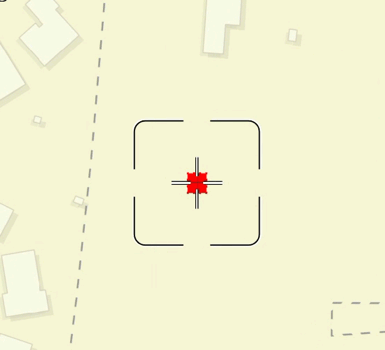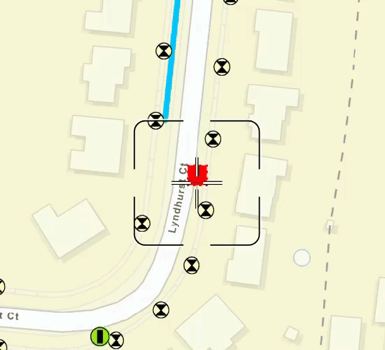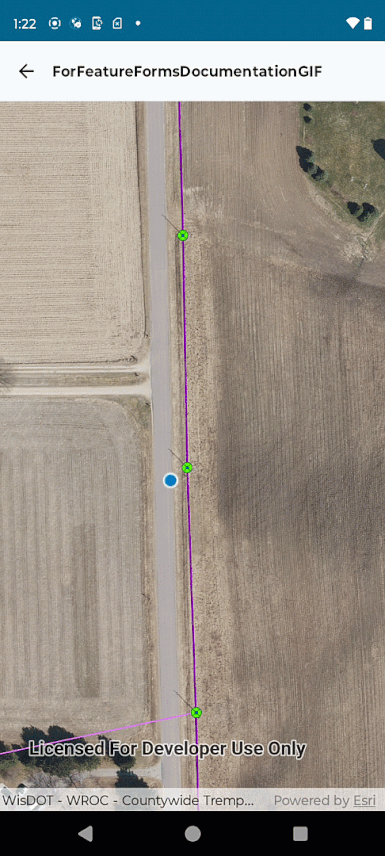This page provides details about enhancements in the 200.5 release of ArcGIS Maps SDK for Kotlin. It also lists deprecations, resolved issues, known issues, and more.
Enhancements
Geometry editor
Reticle
A ReticleVertexTool is now available for the GeometryEditor, introducing a new way of creating and editing geometries tailored for touch interactions. The tool allows a user of a touch device to clearly see where vertices will be created or moved to, without visual feedback being hidden by fingers or a stylus.
When the ReticleVertexTool is active and the GeometryEditor started, pan and zoom the map to place the reticle crosshairs at the required position, then tap to add a vertex.

Place the reticle over an existing vertex and tap to begin a move. Drag the map to place the reticle crosshairs at the new position, then tap a second time to complete the move.

This can be especially useful when using snapping with touch, allowing a user to clearly see which vertices and edges of snap source geometries will be snapped to.

If your users are currently using the magnifier on touch devices to perform edits, you may wish to consider updating your app to take advantage of this new capability. When the reticle is visible, the magnifier will not appear.
Attribute editing with feature forms
Feature form attachments
The new AttachmentsFormElement allows the feature form API and toolkit component to integrate attachment editing into the form experience. When a FeatureForm object is created with a feature that has attachments enabled, the FeatureForm.defaultAttachmentsElement will be populated with a new element object that can be used along with the other elements in the FeatureForm.elements collection.
The AttachmentsFormElement allows adding, deleting, and renaming of new and existing attachments on the feature. The attachment changes are saved or discarded along with all the attribute edits made on the form.
The toolkit component also includes the ability to:
- preview attachment thumbnails
- download and open the full attachment for viewing
- capture a new attachment from the device camera
- add attachments from a file or gallery
Finish editing
The new FeatureForm.finishEditing() method has been added as a complement to FeatureForm.discardEdits(), and should be called in order to persist changes made using the form to the geodatabase. The call will automatically add or update the feature (based on whether it is a new or pre-existing feature) and persist all the attachment changes.
Check for calculated input values
The new FieldFormElement.hasValueExpression property allows API users to customize behaviors like appropriate error messages based upon whether the FieldFormElement.value is calculated or was entered by the app user.
Support for barcode scanner input
The BarcodeScannerFormInput type was added to the ArcGIS Native Maps SDK to support those API users that need to integrate with external scanning hardware. Note that the Feature Form toolkit component does not yet support elements using BarcodeScannerFormInput.

Geotriggers
Support for dynamic feature fences
If you use a FeatureCollectionTable or an ArcGISFeatureTable to create your FeatureFenceParameters and the features are updated, the GeotriggerMonitor will take into account new, updated, or deleted feature fences. This applies to features in the app that are updated locally (through offline sync), and remotely (via a feature service with a refresh interval set).
Utility network
Utility network synchronization
Utility networks can now be edited offline in a mobile geodatabase and synchronized back to an ArcGIS Enterprise 11.3 feature service. Changes made on the client app can be sent up to the feature service (this is referred to as an upload). Changes made on the feature service data can be brought down to the client's mobile geodatabase (this is referred to as a download). Both upload and download can also be completed in a single synchronized bidirectional operation.
Download-only sync is now supported on read-only sync-enabled mobile geodatabases generated with UtilityNetworkSyncMode.SyncSystemAndTopologyTables from ArcGIS Enterprise 11.3 feature services with feature editing capabilities disabled. A download-only sync will automatically incorporate changes into the utility network topology.
Reconcile branch version
Branch-versioned feature services intended for offline sync will typically have sync options set to "Create a version for each download map". Creating a sync-enabled mobile geodatabase based on such a feature service creates a dedicated version for that geodatabase. This version must be reconciled with the default version in order for changes posted to the default version to be downloaded to the client on the next sync.
The new OfflineMapSyncParameters.reconcileBranchVersion and SyncGeodatabaseParameters.reconcileBranchVersion properties allow a sync call to reconcile a sync-enabled mobile geodatabase's version to the default version first in order to pull down any recently posted changes during the sync.
Use SyncCapabilities.supportsBranchVersionReconcile to determine whether the parameter is supported by the feature service.
Trace and edit offline utility networks
In ArcGIS Enterprise 11.3 feature services, mobile geodatabases can be both editable and traceable when created with both the UtilityNetworkSyncMode.SyncSystemAndTopologyTables and SyncModel.Geodatabase options. After an editable and traceable mobile geodatabase is edited, the utility network's topology can be validated to clean up any dirty areas so the edits are reflected in trace results.
Edit associations
Editing associations that model connectivity, containment, and structural attachment between nonspatial and non-coincident network features is now supported by ArcGIS Maps SDK for Native Apps. This requires an Advanced Editing extension license and is supported for utility networks with schema version 4 or higher.
To add a new association, construct a new UtilityAssociation object, check that it is configured correctly with UtilityNetwork.canAddAssociation(), and then call the UtilityNetwork.addAssociation() method.
To delete an existing association, query for the UtilityAssociation object, check that deleting associations is permitted with UtilityNetwork.canDeleteAssociations, and finally call UtilityNetwork.deleteAssociation().
Validate consistency offline
Validate consistency is now supported offline. Setting UtilityTraceConfiguration.validateConsistency to true ensures reliability and accuracy of trace operations by throwing an error if dirty areas exist within the boundaries of the trace. Support is available for schema version 4 or higher mobile geodatabases with full utility network topology.
Validate network topology offline
Calling the UtilityNetwork.validateNetworkTopology() method is now supported for offline utility networks with full topology. Validating network topology will clean up dirty areas. This requires an Advanced Editing extension license. Check the utility network's UtilityNetworkCapabilities.supportsValidateNetworkTopology property to determine whether it supports validation.
Utility network schema version 7
Utility network schema version 7 is now supported by ArcGIS Maps SDK for Native Apps. This provides support for 64-bit Object IDs and big integer fields in addition to other enhancements. See the ArcGIS Pro documentation Upgrade to Utility Network Version 7 for details.
Indoor positioning (IPS)
IndoorPositioningDefinition
The IndoorPositioningDefinition class now has new properties that describe the origin of the data used for indoor positioning as well as the radio type.
IndoorsLocationDataSource
IndoorsLocationDataSource now allows your app to receive detailed information messages from the IPS. When listening, your app can record information messages (into a file, for example) for troubleshooting issues on the client. You can enable receiving information messages with the new setting areInfoMessagesEnabled in the IndoorsLocationDataSourceConfiguration class.
Symbology
Renderer support for ArcGIS scene layers
You can now update or set a new renderer on an ArcGISSceneLayer of type 3D object scene layer or point scene layer. The types of renderer supported by these data types are SimpleRenderer, ClassBreaksRenderer or UniqueValueRenderer.
3DObjects use a mesh symbol built with a material fill symbol layer to display. You can now create a mesh symbol using the new MultiLayerMeshSymbol symbol type and the MaterialFillSymbolLayer symbol layer type.
Full support for Arcade expressions in cluster popups
ArcGIS Maps SDKs for Native Apps now provides full support for the $aggregated variable in the Arcade feature reduction popups. This allows access to the full set of features in a cluster when writing popup expressions.
Cartographic Information Model (CIM) specification
ArcGIS Maps SDKs for Native Apps now supports the latest CIM specification (version 3.3).
Basemaps
Disputed boundary display
A new worldview property on the BasemapStyleParameters class allows the display of different representations of disputed boundaries on a Basemap.
Dynamic basemap styles service updates
This release adds a loadable BasemapStylesService class that retrieves information about the latest features available in the service. Once loaded, the information from the service is presented in a structured and consistent manner using the BasemapStylesServiceInfo, BasemapStyleInfo, BasemapStyleLanguageInfo, and Worldview classes. This enhancement allows the implementation of basemap galleries in applications that automatically add new features to the basemap styles service, without requiring a code change.
New basemap style
The ArcGIS Outdoor style is now available in the Native Maps SDKs.
KML
Extended data
ArcGIS Maps SDK for Native Apps now supports parsing of <Extended data elements, enabling the inclusion of custom metadata within KML files. This enhancement allows developers to embed and visualize additional rich metadata from their KML files.
KML can include both schema-based and non-schema extended data:
-
Schema-based data: Define and use KML schemas to structure extended data, ensuring consistency and clarity. This includes support for
<Schemaand> <Schemaelements, allowing you to define custom data structures.Data > -
Non-schema data: Support for arbitrary key-value pairs through the use of
<Dataelements, providing flexibility for embedding a wide range of metadata without predefined schemas>
Multitrack rendering
With the current release, rendering of multi-tracks in KML is supported. Multitrack <gx combines multiple individual tracks <gx into one multitrack so that they can be displayed as sections of one single path. Depending on the value of <gx element, the icon will stop at the end of one track and jump immediately to the start of the next one or continue on an interpolated path that is between the two tracks.
Popups
Popup date formats
Additional formats for displaying dates in a popup are supported with this release.
| PopupDateFormat enum value | Example |
|---|---|
| dayShortMonthYearLongTime | "Jun 11, 2019, 9:49:00 PM" |
| dayShortMonthYearLongTime24 | "Jun 11, 2019, 21:49:00" |
| dayShortMonthYearShortTime | "Jun 11, 2019, 9:49 PM" |
| dayShortMonthYearShortTime24 | "Jun 11, 2019, 21:49" |
| longDateLongTime | "Tuesday, June 11, 2019, 9:49:00 PM" |
| longDateLongTime24 | "Tuesday, June 11, 2019, 21:49:00" |
| longDateShortTime | "Tuesday, June 11, 2019, 9:49 PM" |
| longDateShortTime24 | "Tuesday, June 11, 2019, 21:49" |
| longMonthDayYearLongTime | "June 11, 2019, 9:49:00 PM" |
| longMonthDayYearLongTime24 | "June 11, 2019, 21:49:00" |
| longMonthDayYearShortTime | "June 11, 2019, 9:49 PM" |
| longMonthDayYearShortTime24 | "June 11, 2019, 21:49" |
Licensing
Edit feature services with a Lite license for data hosted by ArcGIS Location Platform
In general, a Native SDK needs to be licensed at the Basic license level to edit features in a private feature service. In this release, we've enabled the ability to edit features in a private feature service at the Lite license level when the feature data is hosted by ArcGIS Location Platform. The data in this case, is owned by an ArcGIS Location Platform account. This new support applies for both connected and offline workflows. Feature services hosted by ArcGIS Location Platform are always private as they require authentication to access. For more information on data hosting with ArcGIS Location Platform, see the Portal and data services guide.
SDK enhancements
Popup
The composable Popup toolkit component displays a popup for an individual feature. This includes showing the feature's title, attributes, custom description, media, and attachments. ArcGIS Online Map Viewer allows users to create a popup definition by assembling a list of "popup elements". Popup supports the display of popup elements created by the Map Viewer, including Text, Fields, Attachments, and Media (Images and Charts). Popup also supports dynamically updating the elements for dynamic entities.
Callout
The composable Callout toolkit component displays information on the composable Mapview. Callout can contain text or any other composable UI component. The callout can be passed as a lambda to the content parameter of the composable Mapview. Callout also supports dynamic entities by adjusting the leader position as the location of a dynamic entity changes.
Callout container size, color, border thickness, and leader position can also be customized using Callout and Callout.
Gesture Enhancements
Kotlin Maps SDK now supports a single pointer double-tap plus vertical drag gesture. The map or scene can be zoomed in/out continuously using this gesture.
Gesture events on GeoView, such as Down for Geo and Pan for Geo, have been enhanced with a motion property. This property allows access to the underlying Motion, which provides additional information such as the tool type that triggered the gesture, pressure applied by the pointer, and so on. This property is implemented as an extension property on the individual event classes, so import com.arcgismaps.mapping.view.extensions in order to make use of them.
In addition, a new screen property is now exposed on Pan, giving you access to the location of the pointer(s) that caused the pan gesture.
MapView and SceneView can be found in the ArcGIS Maps SDK for Kotlin Toolkit. These composable are now preferred over the Map and Scene classes in the API. When using the composables, pass a lambda as parameter (such as on or on) for each event that you wish to support.Network Request Configuration Enhancements
This release introduces three methods to allow enhanced control over network timeouts. These methods leverage the kotlin.time. class to specify timeout values, offering a more intuitive and flexible way to define timeouts. Below are the details of the newly introduced methods:
-
Read Timeout Configuration: The
ArcGISHttpClient.Builder.readTimeout(timeout: Duration)method allows developers to set the default read timeout for new connections. This timeout is applied to both the TCP socket and for individual read IO operations. The default read timeout value is set to 60 seconds. A value ofDuration.indicates no timeout, while any other value must be between 1 andINFINITE Integer.milliseconds.MAX _VALUE -
Write Timeout Configuration: The
ArcGISHttpClient.Builder.writeTimeout(timeout: Duration)method enables developers to set the default write timeout for new connections. This timeout is specifically applied for individual write IO operations. The default write timeout is set to 10 seconds. Similar to the read timeout, a value ofDuration.signifies no timeout, and all other values must fall within the valid range of 1 toINFINITE Integer.milliseconds.MAX _VALUE -
Connect Timeout Configuration: The
ArcGISHttpClient.Builder.connectTimeout(timeout: Duration)method allows developers to specify the default connect timeout for new connections. This timeout is applied when connecting a TCP socket to the target host. The default connect timeout is set to 10 seconds. As with the other timeouts,Duration.represents no timeout, and any other specified duration must be valid within the range of 1 toINFINITE Integer.milliseconds.MAX _VALUE
These methods will allow for a tailored configuration based on specific application needs.
Breaking API changes
There are no breaking changes in this release.
Behavior changes
GeometryEngine.tryCut()now supports true curve input geometries, preserving true curves in the result geometries.GeometryEngine.bufferGeodeticOrNull()now supports true curve input geometries, producing densified curves in the result geometries.GeotriggerMonitorwill take into account new, updated, or deleted feature fences that are created from aFeatureCollectionTableorArcGISFeatureTableif the features are updated locally within the app, through offline sync, or remotely (via a feature service with a refresh interval set).- Realistic sun: In a scene view, the sun now appears at the correct position in the sky for the specified date, time of day, and geographic location. This feature is enabled only when sunlighting is turned on the
SceneViewclass. - The spatial reference of the
GeoModelis now automatically adopted when loading aServiceFeatureTableor anOgcFeatureCollectionTablebelonging to a layer in thatGeoModel, as long as the layer type supports changing the spatial reference. Previously, the tables were loaded in the layer's spatial reference.
Deprecations
API deprecations
There are no API deprecations in this release.
OS and framework deprecations
There are no OS or framework deprecations in this release.
Issues resolved
Issues addressed in this release are listed below.
- BUG-000154793: The clone property for the feature layer does not clone the respective
Labelto a new feature layer object.Definitions - ENH-000158877: Allow a way to update the features in that trigger geotriggers in ArcGIS Maps SDK for Kotlin (NOTE: this ENH is for .NET but the enhancement is not API specific).
- BUG-000163776: Dictionary Renderer Expression scaling renders incorrectly in 3D.
- BUG-000166643: Repeatedly opening a SceneView intermittently crashes, when the scene has a vector tiled layer.
- BUG-000167816:
Geodatabasecauses Esri.ArcGISRuntime.ArcGISRuntimeException: No Data.Feature Table. Load Aysnc - BUG-000168210: Getting a 'no-data' error when trying to load a geodatabase feature table from a mobile geodatabase.
- BUG-000169090: Improve level of detail selection when no elevation tiles are available.
- Issue reported on Esri Community: Handle missing ows:Constraint in WMTS Capabilities.
- Issue reported on Esri Community: Crash when clearing image overlays from the collection.
Known issues
-
BUG-000171844: Using scheduled updates with ArcGIS Maps SDK for Native Apps incorrectly downloads an entire new replica instead of incremental changes.
-
BUG-000171919: Creating an offline replica, with a full utility network, incorrectly requires that all layers from the feature service are included.
-
BUG-000171920: The
OfflineMapTaskcan fail to create an offline replica when including a utility network.
There are no known issues with this release.
Changes in samples
New Samples
Analysis:
Layers:
Maps:
Routing and Logistics:
Edit and Manage Data:
Enhancements
- All new Kotlin SDK samples will be built utilizing Jetpack Compose, leveraging the GeoView-Compose toolkit module.
- Updated Generate offline map to use the GeoView-Compose toolkit module.
- Updated Show callout to use the GeoView-Compose callout composable.
- Updated Authenticate with OAuth to use the toolkit Authenticator.
Related topics
- System requirements for 200.5
- Install and set up
- Display a map (tutorial)
- Product Life Cycle (Esri Support Site)